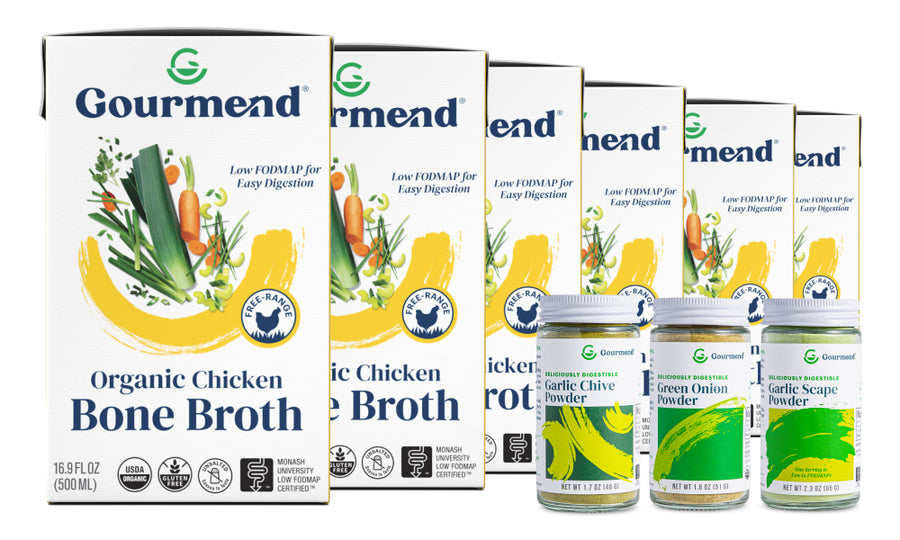What Does Bone Broth Taste Like & How To Enhance It

If you've ever wondered what does bone broth taste like, you're not alone—this ancient superfood has a distinctive flavor profile that surprises many first-time tasters. Unlike the familiar saltiness of traditional soup stocks, bone broth offers a subtle, savory richness with an unmistakably thick, silky texture that comes from hours of slow simmering bones and connective tissues. The result is a deeply nourishing liquid with mild umami notes, a slightly oily mouthfeel, and a complexity that develops on your palate rather than hitting you immediately.
Key Takeaways
- Bone broth has a distinctive flavor profile that surprises many first-time tasters.
- It offers a subtle, savory richness with a thick, silky texture from slow simmering bones and connective tissues.
- The broth has mild umami notes and a slightly oily mouthfeel.
- Its flavor complexity develops gradually on the palate rather than being immediately intense.
- Bone broth is a deeply nourishing liquid with a unique taste compared to traditional soup stocks.
Table of Contents
- Understanding Bone Broth Flavor and Texture
- What Influences How Bone Broth Tastes
- Common Initial Reactions to Bone Broth
- How to Make Bone Broth Taste Better
- Advanced Flavor Enhancement Techniques
- Creative Ways to Incorporate Bone Broth
- Choosing Quality Bone Broth Products
- Maximizing Bone Broth Benefits for Digestive Health
- Long-term Taste Development and Appreciation
For those of us managing digestive sensitivities, bone broth represents more than just a trendy wellness drink—it's a gentle, gut-friendly foundation for countless meals. At Gourmend Foods, we've perfected the art of creating bone broths that deliver both exceptional flavor and digestive comfort, using organic ingredients like chives and leek greens instead of harsh onions that can trigger symptoms. If you're interested in a convenient, gut-friendly option, try our Low FODMAP Organic Chicken Broth or Low FODMAP Organic Beef Broth for a delicious and easy way to enjoy bone broth at home.
Understanding Bone Broth Flavor and Texture
The first sip of quality bone broth often catches people off guard. Where you might expect the bold, salty punch of chicken stock, you instead encounter something more nuanced—a gentle, almost whisper-like savoriness that coats your mouth with a velvety richness. This unique character comes from the extended simmering process that extracts collagen and gelatin from bones, creating that signature thick consistency.
Many describe the initial taste as surprisingly mild, even bland compared to conventional broths. But here's what makes bone broth special: its flavor builds slowly, revealing layers of natural umami from the bones themselves. The texture is perhaps the most distinctive feature—it's noticeably thicker than regular broth, with a silky, sometimes slightly oily coating that indicates the presence of beneficial fats and dissolved collagen.
The Key Difference Between Bone Broth and Soup Stock
Understanding what bone broth tastes like requires knowing how it differs from regular soup stock. Traditional stock is typically thin, flavorful, and often quite salty—designed to punch up soups and sauces with immediate impact. Bone broth, on the other hand, is simmered for 12-24 hours or more, creating a completely different experience.
This extended cooking time breaks down collagen into gelatin, giving bone broth its characteristic thickness and that slightly viscous mouthfeel. When chilled, quality bone broth will actually gel—a sign that it's rich in the nutrients that make it so valuable for digestive health. The Gourmend Foods bone broths, both chicken and beef varieties, achieve this perfect gelatinous consistency through careful attention to cooking time and ingredient quality. If you want to experience both, consider our Bone Broth Sampler Bundle to taste the difference for yourself.
What Influences How Bone Broth Tastes
Several factors dramatically impact what does bone broth taste like in your cup. The protein source makes perhaps the biggest difference—chicken bone broth tends to offer a milder, more familiar flavor with comforting, nostalgic notes that remind many people of homemade chicken soup. Beef bone broth, conversely, delivers a more robust, earthy profile with deeper savory notes that can be quite bold.
The aromatics added during cooking play a crucial role in developing flavor complexity. While traditional recipes might call for onions and garlic, we use gut-friendly alternatives like chives and the green parts of scallions to build that savory foundation without triggering digestive discomfort. These ingredients provide bright, onion-like flavors while remaining gentle on sensitive stomachs. For a plant-based option, our Low FODMAP Organic Vegetable Broth is crafted with the same attention to flavor and digestive wellness.
Cooking Duration and Quality Impact
Longer simmering times don't just affect texture—they fundamentally change the taste profile. A 12-hour simmer yields different flavors than a 24-hour cook, with extended times generally producing deeper umami notes and more concentrated mineral flavors. The quality of bones matters enormously too; grass-fed, pasture-raised sources create broths with more complex flavors and superior nutritional profiles.
At Gourmend Foods, we source only the highest-quality organic bones and simmer them to perfection, ensuring each batch delivers consistent flavor and that characteristic gel-like consistency when cooled. Our broths also feature unique additions like nori seaweed and oyster mushrooms, which contribute natural umami depth without any artificial flavor enhancers.
Common Initial Reactions to Bone Broth
Does bone broth taste good on first sip? Honestly, many people find their initial experience underwhelming. The lack of salt, the unfamiliar thickness, and that subtle flavor profile can be jarring if you're expecting something more like traditional chicken soup. Some describe it as "too mild" or even "oily," and these reactions are completely normal.
The key is understanding that bone broth is an acquired taste for many people. Think of it like learning to appreciate good wine or dark chocolate—the complexity reveals itself gradually. What initially seems bland often transforms into something deeply satisfying as your palate adjusts to the subtle interplay of minerals, amino acids, and natural fats.
Why Texture Matters
The viscous, slightly oily mouthfeel can be the biggest hurdle for newcomers. This texture comes from beneficial compounds like collagen and healthy fats that support gut health and joint function. Rather than seeing it as a drawback, try to appreciate it as a sign of quality—thin, watery bone broth simply hasn't been simmered long enough to extract these valuable nutrients.
For those managing IBS or other digestive sensitivities, this rich texture can actually be soothing to the digestive tract. The gelatin acts as a gentle coating that may help support gut lining integrity, making bone broth not just nourishing but potentially therapeutic for sensitive stomachs. For more information on digestive health and low FODMAP diets, check out our FODMAP blog.
How to Make Bone Broth Taste Better
 bone broth taste better">
bone broth taste better">
If your first encounter with bone broth left you wondering how to make bone broth taste better, you're in good company. The beauty of bone broth lies in its versatility as a flavor canvas—it readily accepts enhancements that can transform it from subtle to spectacular. The key is starting gradually and building flavors that complement rather than mask its natural richness.
We recommend beginning with simple additions that enhance the existing umami profile. A pinch of high-quality sea salt can immediately brighten the flavors and make the broth more familiar to your palate. From there, you can experiment with herbs, spices, and healthy fats that align with your taste preferences and dietary needs. If you want to try a variety of broths and seasonings, the Broth Sampler is a great way to discover your favorites.
Gradual Taste Adaptation Strategies
Think of acclimating to bone broth like learning to enjoy black coffee—small, frequent exposure helps retrain your taste buds. Start by mixing your bone broth with a traditional chicken or vegetable stock, using a higher ratio of familiar stock to bone broth initially. Gradually increase the bone broth portion over several weeks as your palate adapts to its unique characteristics.
This blending approach works particularly well for people with sensitive stomachs who want to ease into bone broth consumption. You get some of the nutritional benefits while maintaining flavors that feel comfortable and familiar. The Gourmend Foods bone broths blend beautifully with other liquids because of their clean, organic ingredient profile.
Basic Seasoning Boosters
Salt and pepper remain the simplest way to enhance bone broth flavor, but don't stop there. Fresh cracked black pepper adds warmth and slight heat that complements the rich mouthfeel beautifully. A squeeze of fresh lemon juice can brighten the entire cup, adding acidity that balances the richness and makes each sip more refreshing.
Healthy fats like grass-fed butter, ghee, or a drizzle of extra virgin olive oil can enhance both flavor and satiety. These additions make the broth feel more substantial and can help slow the absorption of nutrients, making it a more satisfying meal replacement or snack. For those looking to add a savory, allium-rich boost without digestive upset, try our Low FODMAP Garlic Chive Salt as a finishing touch.
Advanced Flavor Enhancement Techniques
Once you've mastered basic seasonings, the real fun begins with more creative flavor combinations. Herbs and spices can completely transform what does bone broth taste like, taking it from simple to sophisticated with just a few additions. The key is understanding which flavors work harmoniously with bone broth's natural umami base.
Fresh herbs like rosemary, thyme, and sage add earthy, aromatic notes that complement both chicken and beef bone broths. For those following a low FODMAP approach, garlic chives provide that beloved garlic flavor without the digestive triggers of garlic bulbs. These small green shoots deliver similar aromatic compounds but in gut-friendly concentrations.
Warming Spices and Global Flavors
Ginger and turmeric create an anti-inflammatory powerhouse while adding warming, slightly spicy notes that make bone broth feel like a healing elixir. A pinch of cayenne or red pepper flakes can add gentle heat that enhances circulation and makes the broth more invigorating. For those who enjoy curry flavors, a small amount of curry powder or individual spices like coriander and cardamom can create an entirely new taste experience.
Asian-inspired additions work particularly well with bone broth's umami character. A small amount of low-sodium tamari, a few drops of sesame oil, or a pinch of nori flakes can create a deeply savory, almost restaurant-quality broth. These additions align perfectly with the nori seaweed already present in Gourmend Foods bone broths.
Acidic Elements for Brightness
Acidity is often the missing element that transforms good bone broth into great bone broth. Apple cider vinegar, lemon juice, or lime juice can cut through the richness and add complexity that keeps you coming back for more. Start with just a teaspoon and adjust to taste—you want brightness, not sourness.
These acidic additions also serve a functional purpose for those with digestive sensitivities. The gentle acidity can help stimulate digestive enzymes, potentially making the nutrients in bone broth more bioavailable and easier to digest. For more on the science behind digestion and enzyme stimulation, see this authoritative overview on apple cider vinegar and digestion.
Creative Ways to Incorporate Bone Broth
Sometimes the best approach to enjoying bone broth isn't drinking it straight but incorporating it into foods you already love. Using bone broth as a cooking liquid for rice, quinoa, or other grains infuses them with extra protein and minerals while creating more flavorful side dishes. This method works especially well for people who find the texture of straight bone broth challenging. For inspiration, check out our Simple Low FODMAP Gourmet Risotto recipe.
Bone broth makes an excellent base for smoothies, particularly green smoothies where its mild flavor gets masked by stronger ingredients like spinach, ginger, and fruit. You get all the nutritional benefits without having to acquire a taste for sipping it plain. This approach works well for busy mornings when you want nutrition but need familiar flavors.
As a Cooking Liquid
Replace water with bone broth when making soups, stews, or sauces to add depth and nutrition without changing cooking methods. The gentle flavor of quality bone broth enhances rather than overwhelms other ingredients, making it perfect for delicate dishes. When cooking vegetables, using bone broth instead of water creates more satisfying, restaurant-quality results.
For those managing digestive issues, cooking grains and legumes in bone broth can make them easier to digest while boosting their nutritional value. The amino acids and minerals in bone broth may help support digestive function, making it an ideal cooking medium for sensitive stomachs.
As a Recipe Base
Bone broth works beautifully in mashed potatoes, creating creaminess without dairy for those avoiding lactose. It can replace some of the liquid in meatball mixtures, adding moisture and flavor while boosting protein content. Even in baked goods like savory muffins or bread, small amounts of bone broth can add richness and nutrition.
The clean ingredient profile of Gourmend Foods bone broths makes them particularly suitable for these applications. With no artificial flavors, preservatives, or additives, you can use them confidently in any recipe where you want pure, wholesome enhancement rather than competing flavors.
Choosing Quality Bone Broth Products
Understanding what does bone broth taste like becomes much easier when you start with high-quality products. Not all bone broths are created equal, and the source, preparation method, and ingredient quality dramatically impact both flavor and nutritional value. When evaluating bone broth options, look for products that prioritize ingredient transparency and traditional preparation methods. If you're looking to stock up, the Broth Lover Bundle is perfect for regular bone broth drinkers.
The best bone broths should have a rich, gelatinous texture when chilled, indicating proper collagen extraction from long, slow simmering. They should taste clean and robust without artificial enhancement or excessive sodium masking poor-quality ingredients. Gourmend Foods bone broths exemplify these qualities, using organic, grass-fed bones and aromatics like chives and leek greens instead of high-FODMAP onions and garlic bulbs.
Ingredient Quality Indicators
Grass-fed and pasture-raised sources produce bone broths with superior flavor complexity and nutritional density. These animals typically have better fatty acid profiles and higher mineral content in their bones, resulting in more flavorful and nutritious broths. Look for products that specify their sourcing practices rather than using vague terms like "natural" or "farm-fresh."
Avoid bone broths with artificial flavors, preservatives, or excessive sodium content, which often indicate shortcuts in the preparation process. Quality bone broths should list recognizable whole food ingredients and minimal additives. The Gourmend Foods bone broths contain only organic vegetables, herbs, and bones—nothing artificial or unnecessary.
Preparation Method Importance
Traditional bone broth preparation involves simmering bones for 12-24 hours to extract maximum collagen, minerals, and flavor compounds. This extended cooking time creates the characteristic thickness and rich mouthfeel that distinguishes true bone broth from regular stock. Products that rush this process often result in thin, less flavorful broths with minimal nutritional benefits.
Quality producers will mention their simmering time and preparation methods on packaging or websites. They understand that proper bone broth preparation cannot be rushed and that the time investment directly correlates with the final product's quality and nutritional value.
Maximizing Bone Broth Benefits for Digestive Health
For those dealing with digestive sensitivities or following a low FODMAP approach, bone broth can be particularly beneficial when chosen and prepared correctly. The amino acids in bone broth, particularly glycine and glutamine, may support gut lining integrity and overall digestive comfort. However, not all bone broths are suitable for sensitive stomachs.
Traditional bone broths often contain high-FODMAP ingredients like onions and garlic bulbs, which can trigger symptoms in people with IBS or other digestive issues. This is where carefully formulated products like Gourmend Foods bone broths become invaluable—they provide all the benefits of traditional bone broth while using low FODMAP alternatives like chives and scallion greens for flavor.
Timing and Consumption Strategies
The timing of bone broth consumption can impact how to make bone broth taste better and how well your body tolerates it. Many people find that sipping warm bone broth between meals helps with digestion and provides sustained energy without the blood sugar spikes associated with snacking. Starting with smaller portions allows your digestive system to adapt gradually.
For optimal digestive benefits, consider consuming bone broth on an empty stomach in the morning or as an afternoon pick-me-up. This timing allows the amino acids and minerals to be absorbed efficiently without competing with other foods for digestion. The warm temperature can also help stimulate digestive enzymes naturally.
Combining with Complementary Foods
Pairing bone broth with easily digestible foods can enhance both flavor and nutritional absorption. Simple additions like cooked rice, well-cooked vegetables, or small amounts of healthy fats create more substantial meals while maintaining digestive gentleness. These combinations help make bone broth more satisfying and meal-like rather than just a beverage.
For those following specific dietary protocols, bone broth serves as an excellent base for elimination diets or gut-healing programs. Its nutrient density and gentle nature make it suitable for sensitive periods while providing essential amino acids and minerals that support recovery and healing. For more low FODMAP meal ideas, visit our Low FODMAP Recipes blog.
Long-term Taste Development and Appreciation
Developing an appreciation for bone broth is often a gradual process that rewards patience and experimentation. Many people find that their taste preferences evolve over time, with initially challenging flavors becoming comforting and satisfying. This adaptation process is particularly common with nutrient-dense foods that provide genuine nourishment rather than artificial stimulation.
Regular consumption helps calibrate your palate to appreciate subtler flavors and the satisfying quality of genuine nutrition. What initially seems bland may eventually taste rich and complex as your taste buds become more sensitive to natural flavors rather than artificial enhancement. This process mirrors how people often develop preferences for less processed foods over time.
The key to long-term success with bone broth lies in finding preparation methods and flavor combinations that work for your individual preferences and dietary needs. Whether you prefer it as a warming morning ritual, an afternoon energy boost, or incorporated into favorite recipes, bone broth can become a valuable addition to a health-conscious lifestyle. With high-quality options like Gourmend Foods bone broths available, you can explore this ancient superfood with confidence, knowing you're getting clean, organic nutrition that supports both flavor and digestive wellness. For more educational content, browse our Learn blog.
Frequently Asked Questions
Does bone broth taste good to drink?
Whether bone broth tastes good is subjective and depends on personal preference. Many people enjoy its rich, savory, and slightly gelatinous flavor, which is deeper and more complex than regular broth. However, some might find the taste earthy or strong, especially if the broth is homemade with a long simmer time. Adding herbs and seasonings can enhance its flavor and make it more enjoyable.
Why do I feel weird after drinking bone broth?
Feeling weird after drinking bone broth could be due to several reasons, such as a detox reaction if your body is adjusting to the nutrients or a sensitivity to certain compounds like glutamates or histamines present in the broth. It might also result from the high mineral content or additives if you are consuming store-bought versions. If symptoms persist, it’s best to consult a healthcare professional to rule out allergies or intolerances.
Does bone broth taste like regular chicken broth?
Bone broth and regular chicken broth share some similarities but have distinct differences in taste. Bone broth tends to have a richer, deeper, and more gelatinous flavor due to the long simmering of bones, which releases collagen and minerals. Regular chicken broth is usually lighter and clearer, made primarily from meat and vegetables, resulting in a more delicate taste.
What is the downside of bone broth?
One downside of bone broth is that it can contain high levels of certain minerals like lead, depending on the source of the bones, which might pose health risks if consumed excessively. It also may have a strong taste that not everyone enjoys, and making it at home requires a long cooking time. Additionally, bone broth lacks significant protein compared to other protein-rich foods, so relying on it as a primary nutrition source isn’t advisable.
Is store-bought bone broth healthy?
Store-bought bone broth can be healthy, especially if it’s made with quality ingredients and minimal additives. It typically provides essential minerals and collagen beneficial for joint and skin health. However, some commercial products may contain preservatives, excess sodium, or artificial flavors, so checking the label is important to ensure you’re choosing a nutritious option.
How do you drink bone broth if you hate the taste?
If you dislike the taste of bone broth, try enhancing it with herbs, spices, or a splash of lemon juice to brighten the flavor. You can also incorporate it into soups, stews, or sauces where other ingredients mask its strong taste. Drinking it warm with a pinch of salt or a bit of hot sauce can make it more palatable, and gradually getting used to its flavor might help as well.







